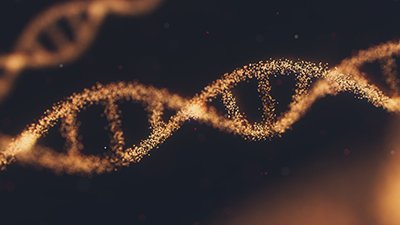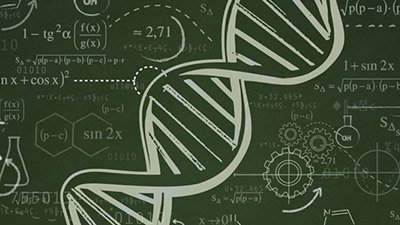Making the Evolution Pill Easier to Swallow
Part 1
Dr. Georgia Purdom attended a series of lectures titled “Your Genes and You: Health, Disease, and Medicine.” The title might better have been “Sleight of Hand.”
Several weeks ago I attended a series of lectures titled “Your Genes and You: Health, Disease, and Medicine” offered by the University of Cincinnati (UC) Communiversity Program. The title of the series seemed innocuous; however, I would soon find out the real motive was another attempt to sell evolution to the public.
The audience of 100 or so consisted mainly of students and the general public (known from show of hands regarding questions about educational levels). The moderator the first evening stated that the original topic suggested for the event was a series of lectures to honor Darwin. This is not surprising, since many universities, including UC, have had such programs on campus during the so-called Year of Darwin. However, the moderator said he thought that idea was all wrong.
After attending the lectures it was very obvious that the organizers thought a direct approach to honor Darwin was wrong—but an indirect approach was more appropriate. They would attempt to show that evolutionary ideas were a necessary foundation for modern medicine.
I was reminded of the movie Arsenic and Old Lace. In the movie, two women kill multiple men by putting a mixture of poisons in wine they give them to drink. The men cannot taste the poison in the wine and don’t realize the danger in drinking the wine. These scientists are doing much the same thing by taking evolutionary ideas (poison) and connecting them to modern medicine (wine) and presenting it to the public. An unsuspecting public just nods their heads in approval and doesn’t realize the faulty connections being made and the dangers of accepting evolutionary ideas.
The first lecture was titled “Fundamentals of Human Genetics and Genomics” and was a crash course in genetics dealing with DNA, RNA, and proteins.1 The presenter gave some interesting facts about DNA:
- The Beijing Institute of Genomics can sequence one person’s DNA in two days.
- One gene expressed in the brain can produce more than 50,000 slightly different varieties of a protein, which varies between individual neurons.
- 40% of the human genome is composed of viral sequences.
Then out of the blue the presenter stated that human and chimp DNA share 99% similarity. This is demonstrably false! Chimps have 12% more DNA than humans and many other differences that are not represented in a 99% figure often presented to the public. This section of the presentation on chimp/human DNA comparison didn’t fit well with the flow of the presentation and was likely added to try to show some connection between Darwin, evolution, and genetics. The lecture ended with information on nutrigenetics and how a mother’s diet affects gene expression in her offspring. Overall it was a good lecture on genetics with just a few gratuitous mentions of evolution.
The second lecture was titled “Darwin, Evolution, and Why We Metabolize Drugs Differently.” The presenter began with a brief history of the life of Darwin and then explained ten inferences of Darwin’s “theory of evolution.” The first nine inferences had nothing to do with evolution (in the commonly understood sense of molecules-to-man), but instead were relevant to natural selection.
For example, inference number 8 was “individuals more suited to the environment are more likely to survive and more likely to reproduce.” This is the observable process of natural selection that occurs in the present and allows organisms to adapt to their environment. The tenth inference referred to molecules-to-man evolution and stated that changes over “interminable generations” (i.e., millions of years) would eventually lead to “new species” (i.e., dinosaurs into birds). However, this is an extrapolation made about the unobservable past based on man’s ideas.
The presenter gave ten examples (from among hundreds he claimed) in support of evolution. The second example was eye evolution. His slide read, “How could something as magnificent and complex as our EYE possibly have “evolved” (instead of created by ‘Intelligent Design’)?” The presenter then proceeded to tell the audience that over three billion years complex “eyes” have evolved independently 40–65 times from our single-celled ancestors with eyespots that detect light. He basically told the audience the beginning of the story and the end of the story, but not the middle. He failed to give any evidence or to provide any mechanisms for how an eyespot could evolve into a complex eye. Apparently, since evolution is true (in his mind) and we now have eyes, it must have happened—and by random chance 40–65 separate times!
Another example of evolution was that all humans develop arthritis of the lower spine. The slide read, “The vertebrate spine of mammals is best designed for walking on all fours.” I asked Dr. Tommy Mitchell (MD, Vanderbilt University) about the truthfulness of these statements. He said not everyone develops arthritis of the lower spine and if someone thinks that humans were best designed to walk on all fours to do it for a week and then see what they thought! (I know from playing “horsey” with my daughter for ten minutes that humans were not designed to walk on all fours!).
Throughout the lecture the presenter stated many times why something evolved (i.e., responding to changes in diet or climate), but never how. The vast majority of examples used were evidence for natural selection—such as antibiotic resistance in bacteria—not molecules-to-man evolution. This is contrary to what science is supposed to do in the minds of many evolutionists. They say science should focus more on answering how and leave religion to answer why.
The last few minutes of the lecture focused on trying to relate the previously given information on evolution to why different ethnicities metabolize drugs differently. Diet and climate were emphasized as major factors (as they were in other examples). While this may be true, it has nothing to do with molecules-to-man evolution and everything to do with adaptation and natural selection.
The presenter’s conclusion slide read, “Darwin’s “theory of evolution” has now gained experimental support from hundreds of examples (“Law of Evolution”?).” However, he did not show any experimental support for evolution, but did tell a lot of stories that sadly seemed to enchant the audience and probably had many people thinking that evolution should not be a “theory,” but a “law.”
Nonetheless, it was a profitable event, and I learned some interesting facts and more good examples of natural selection. Don’t miss Part 2 where I will relate how Darwin and evolution are supposedly connected to birth defects and vaccine/antibiotic production.
Read part two of this series.
Footnotes
- All lectures were given by doctors associated with UC College of Medicine.
Recommended Resources

Answers in Genesis is an apologetics ministry, dedicated to helping Christians defend their faith and proclaim the good news of Jesus Christ.
- Customer Service 800.778.3390
- Available Monday–Friday | 9 AM–5 PM ET
- © 2026 Answers in Genesis





